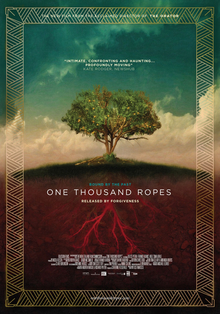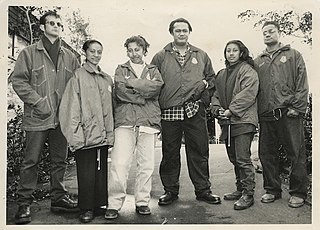
Samoa, officially the Independent State of Samoa and until 1997 known as Western Samoa, is a Polynesian island country consisting of two main islands ; two smaller, inhabited islands ; and several smaller, uninhabited islands, including the Aleipata Islands. Samoa is located 64 km (40 mi) west of American Samoa, 889 km (552 mi) northeast of Tonga, 1,152 km (716 mi) northeast of Fiji, 483 km (300 mi) east of Wallis and Futuna, 1,151 km (715 mi) southeast of Tuvalu, 519 km (322 mi) south of Tokelau, 4,190 km (2,600 mi) southwest of Hawaii, and 610 km (380 mi) northwest of Niue. The capital and largest city is Apia. The Lapita people discovered and settled the Samoan Islands around 3,500 years ago. They developed a Samoan language and Samoan cultural identity.

An Angel at My Table is a 1990 biographical drama film directed by Jane Campion. The film is based on Janet Frame's three autobiographies, To the Is-Land (1982), An Angel at My Table (1984), and The Envoy from Mirror City (1984). The film was very well received. It won awards at the New Zealand Film and Television awards, the Toronto International Film Festival, and second prize at the Venice Film Festival.

New Zealand humour bears some similarities to the body of humour of many other English-speaking countries. There are, however, several regional differences.

Tui Ātua Tupua Tamasese Tupuola Tufuga Efi is a Samoan political leader and as holder of the maximal lineage Tama-a-'āiga title of Tupua Tamasese, is one of the four paramount chiefs of Samoa. He also holds the royal pāpā title of Tui Atua.

The O le Ao o le Malo is the head of state of Samoa. The position is described in Part III of the 1960 Samoan constitution. At the time the constitution was adopted, it was anticipated that future heads of state would be chosen from among the four Tama a 'Aiga "matai" paramount chiefs in line with customary protocol. This is not a constitutional requirement, so Samoa can be considered a parliamentary republic rather than a constitutional monarchy. The government Press Secretariat describes Head of State as a "ceremonial president". The holder is given the formal style of Highness, as are the heads of the four paramount chiefly dynasties.

Falefā is located on the north eastern coast of Upolu island in Samoa. It was the ancient capital during the ‘Malo’ (‘government’) of Tupu Tafa'ifa (King) Fonoti. After having defeated his siblings Va'afusuaga and Samalaulu for control of Samoa, King Fonoti chose to rule from his new seat in Falefa, an honour remembered in its faalupega to this day.

An indirect election was held in Apia to elect the O le Ao o le Malo of Samoa on 16 June 2007 after the death of the country's head of state for four and a half decades, Malietoa Tanumafili II, in May 2007. Former Prime Minister Tui Ātua Tupua Tamasese Efi was elected unopposed by the 49-member strong parliament. This O le Ao o le Malo election was the first to occur since Samoa gained independence in 1962.

Fa'amatai is the indigenous political ('chiefly') system of Samoa, central to the organization of Samoan society. It is the traditional indigenous form of governance in both Samoas, comprising American Samoa and the Independent State of Samoa. The term comprises the prefix fa'a and the word matai.
Samoan literature can be divided into oral and written literatures, in the Samoan language and in English or English translation, and is from the Samoa Islands of independent Samoa and American Samoa, and Samoan writers in diaspora. Samoan as a written language emerged after 1830 when Tahitian and English missionaries from the London Missionary Society, working with Samoan chiefly orators, developed a Latin script based Samoan written language. Before this, there were logologo and tatau but no phonetic written form.
Kas Futialo, known by the stage name Tha Feelstyle, is a New Zealand hip hop artist of Samoan descent. His first album was Break It To Pieces in 2004. Tha Feelstyle was born in Samoa and moved to New Zealand in the 1980s. He raps in English as well as the Samoan language.
Samoa's first ever feature film, The Orator, was released in 2011. Shot and set in Samoa, in the Samoan language, it has a Samoan cast. It was produced with financial support from the Samoan government, in the hopes of showcasing Samoan culture to an international audience, and of promoting Samoa as a tourist destination.

The 68th annual Venice International Film Festival was held in Venice, Italy between 31 August and 10 September 2011. American film director Darren Aronofsky was announced as the Head of the Jury. American actor and film director Al Pacino was presented with the Glory to the Film-maker award on 4 September, prior to the premiere of his upcoming film Wilde Salomé. Marco Bellocchio was awarded with the Golden Lion for Lifetime Achievement in September. The festival opened with the American film The Ides of March, directed by George Clooney, and closed with Damsels in Distress by Whit Stillman.
Tusi Tamasese is a Samoan New Zealander film director.
Fa'afiaula Sagote was a Samoan actor.
The 2012 Sorta Unofficial New Zealand Film Awards was the first presentation for the Sorta Unofficial NZ Film Awards, a New Zealand film industry award.
Leon Gordon Alexander Narbey is a New Zealand cinematographer.

One Thousand Ropes is a 2017 New Zealand drama film directed by Tusi Tamasese. It was screened in the Panorama section at the 67th Berlin International Film Festival. It was selected as the New Zealand entry for the Best Foreign Language Film at the 90th Academy Awards, but was not nominated.
The Topp Twins: Untouchable Girls is a New Zealand documentary film, directed by Leanne Pooley and released in 2009. The film profiles The Topp Twins, a lesbian comedy music duo from New Zealand.

Pacific Underground is a New Zealand performing arts collective, founded in 1993 in Christchurch, New Zealand, to produce contemporary performing art that reflects the group's Pacific Island heritage. In 2016 they received a Lifetime Achievement Award at the Pacific Music Awards. They are the longest running Pacific contemporary performing arts organisation in New Zealand.










